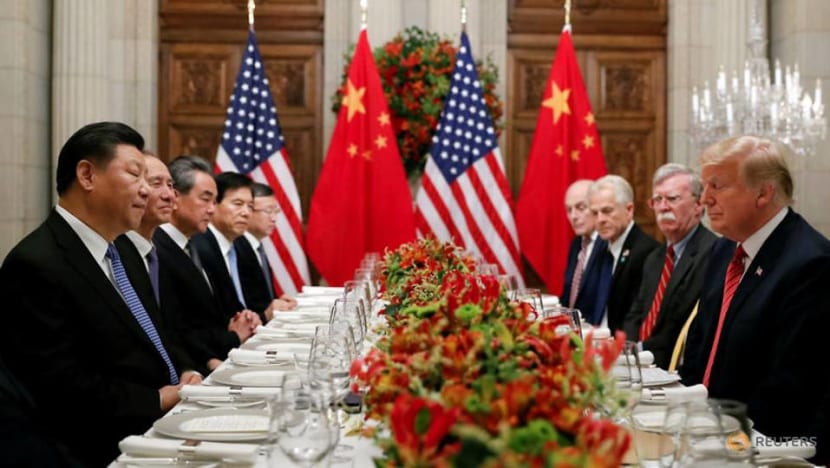Commentary: China plans, America reacts
While China has a strategic planning process, America has neither a plan nor a strategy, says economist Stephen S Roach.

US President Donald Trump and Chinese President Xi Jinping attend a working dinner after the G20 leaders summit in Buenos Aires, Argentina on Dec 1, 2018. (File photo: REUTERS/Kevin Lamarque)
NEW HAVEN, Connecticut: China’s leaders are hard at work putting the finishing touches on the country’s 15th Five-Year Plan. Meanwhile, since the beginning of his second term, US President Donald Trump has issued a record 205 executive orders and signed only a handful of bills into law.
The comparison is striking: While China has a strategic planning process, America has neither a plan nor a strategy.
The planning exercise is a foundational pillar of the People’s Republic of China. The first plan ran from 1953 until 1957 and was strongly influenced by Mao Zedong’s post-revolutionary relationship with Joseph Stalin. Over the ensuing years, the plans became more elaborate, as did the preparation process.
The State Planning Commission that set Soviet-style industry targets in the early 1950s was eventually replaced by the National Development and Reform Commission (NDRC). In addition to following the guidance of the Communist Party of China and drawing on the expertise of the ministries that comprise the State Council, the NDRC consults with outside academics and industry leaders.
The gestation period for China’s planning process is long: As soon as the National People’s Congress approves a five-year plan, work on the next one commences.
China’s five-year plans have been far from perfect. The first four were unmitigated disasters, dominated by Mao’s ideological zealotry and overreach. The second plan (1958 to 1962) featured the catastrophic Great Leap Forward, while the fourth plan (1971 to 1975) was shaped by the disastrous Cultural Revolution.
It wasn’t until the fifth plan (1976 to 1980), which ushered in Deng Xiaoping’s post-Mao reforms and opened up the economy, that the planning process became more proactive and focused on boosting growth and prosperity. The ninth plan (1996 to 2000) unleashed a wave of reforms to overhaul state-owned enterprises.
The 11th (2006 to 2010) and 12th plans (2011 to 2015) laid the groundwork for China’s consumer-led rebalancing strategy, an unfinished agenda item that many hope will be refined in the upcoming 15th plan (2026 to 2030).
AMERICA ABHORS PLANNING
By contrast, America abhors planning. The “invisible hand” of the market, not government targets and directives, allocates the country’s scarce resources. In theory, monetary and fiscal policymakers can guide and intervene in the US economy, aided by the interplay between executive and congressional authority over federal budgeting. But in practice, that process has all but broken down under intensifying political polarisation.
Over the past three decades, partisan battles over spending cuts (in the Clinton era), healthcare (in the Obama era), and the border wall (in Trump’s first term) have caused a series of government shutdowns. Now, another fight looms over the One Big Beautiful Bill Act’s spending cuts and the trillions of dollars its tax cuts will add to the deficit.
Industrial policy blurs the distinction between Chinese-style central planning and the invisible hand. In China, industrial policy is a logical extension of long-term goal setting and has recently included the Made in China 2025 program, the Internet Plus Action Plan, the New Generation Artificial Intelligence Development Plan, and the recent AI Plus Plan.
In comparison, US industrial policy is reactive – addressing other countries’ supposedly unfair competitive practices in sectors that American politicians judge to be of paramount importance.
Trump’s own deal-driven, transactional strain of industrial policy has prompted many to ask whether he has become a state capitalist. After all, he has intervened in support of Intel, US Steel, and the rare earths firm MP Materials; negotiated a cut from Nvidia and AMD’s chip sales to China; and established sweetheart tariff exemptions for Apple and TSMC.
In some ways, these initiatives are a sequel to his predecessor Joe Biden’s industrial policies, which included direct support for infrastructure, semiconductors, and green energy technologies. But Trump’s approach is less strategic and more about direct intrusion into company-specific decision-making.
CHINA IN A LEAGUE OF ITS OWN
Trump and Biden were not the first US presidents to embrace industrial policy. In 1961, a month after the Soviet Union completed the first manned space flight, John F Kennedy famously set the goal of landing a man on the Moon by the end of the decade, which America did.
And the US Defense Department established the Defense Advanced Research Projects Agency (DARPA) as an internal industrial-policy mechanism to support frontier research that led to transformative technologies, including the internet, semiconductors, nuclear power, advanced materials, and GPS navigation.
China and the US are hardly alone in relying on industrial policy. After World War II, Japan embraced the model of a “plan-rational developmental state.” France embraced indicative planning, and West Germany’s Wirtschaftswunder was fuelled in part by industrial policy aimed at supporting small and medium-sized enterprises.
But the West’s actions, including Japan’s earlier industrial policies, cannot compare to China’s strategic, comprehensive “all-of-government” approach, which is in a league of its own. The Chinese government draws on the country’s surplus domestic savings to target industries of the future, while marshalling the full resources of the NDRC, state-owned enterprises, state-directed banks and state-supported investment funds.
Trump’s transactional interventions not only lack an overarching strategy; their scope will be limited by a US economy that is short on domestic savings, increasingly saddled with big, ugly federal budget deficits. Moreover, amid a full-blown outbreak of Sinophobia, there is strong bipartisan distaste for anything resembling Chinese-style market-based socialism.
For all the talk of America entering a new golden age, Trumponomics will ultimately do little to address long-term US competitiveness. In fact, the administration’s proposed funding cuts for basic research risk squandering US innovation capabilities.
Trump’s approach to governance – which favours policymaking through executive order, rather than legislative means – reflects an authoritarian strain of executive overreach that recalls the chaotic five-year plans of the Mao era. Just as those missteps led to China’s Cultural Revolution, many (including me) have argued that there may be reason to fear comparable turmoil in the US.
Stephen S Roach is a faculty member at Yale University and former chairman of Morgan Stanley Asia. This commentary first appeared on Project Syndicate.
















